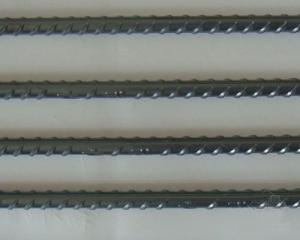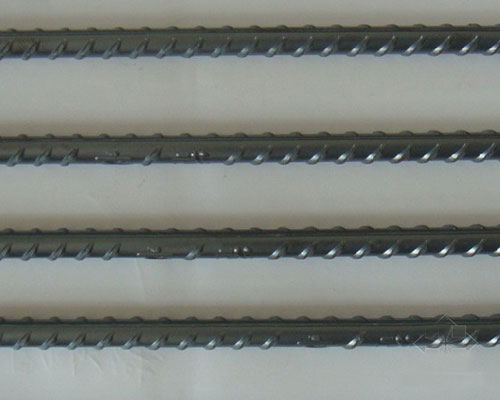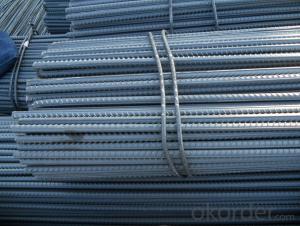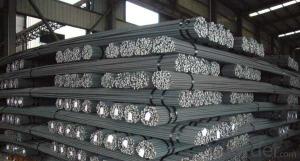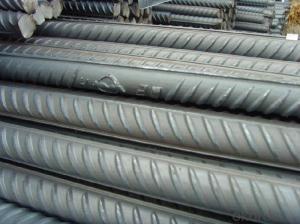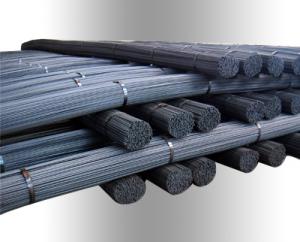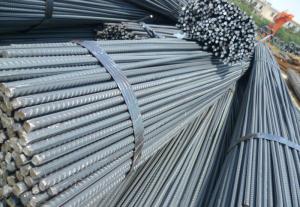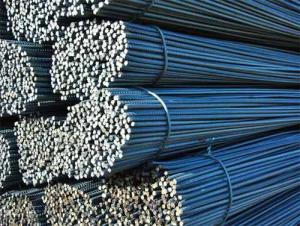Cold Rolled Steel Rebar 10mm
- Loading Port:
- China Main Port
- Payment Terms:
- TT OR LC
- Min Order Qty:
- -
- Supply Capability:
- -
OKorder Service Pledge
OKorder Financial Service
You Might Also Like
Usage and Applications of Hot Rolled Steel Rebar:
Deformed bar is widely used in buildings, bridges, roads and other engineering construction. Big to highways, railways, bridges, culverts, tunnels, public facilities such as flood control, dam, small to housing construction, beam, column, wall and the foundation of the plate, deformed bar is an integral structure material. With the development of world economy and the vigorous development of infrastructure construction, real estate, the demand for deformed bar will be larger and larger..
Packaging & Delivery of Hot Rolled Steel Rebar:
Packaging Detail: products are packed in bundle and then shipped by container or bulk vessel, deformed bar is usually naked strapping delivery, when storing, please pay attention to moisture proof. The performance of rust will produce adverse effect.
Each bundle weight: 2-3MT, or as required
Payment terms: TT payment in advance or Irrevocable LC at sight.
Trade terms :FOB, CFR, CIF
Label:to be specified by customer, generally, each bundle has 1-2 labels
Steel Rebar in stock
Cold Rolled Techniques
Yield Point: 545-565mpa
Deformed bar is widely used in buildings, bridges, roads and other engineering construction. Big to highways, railways, bridges, culverts, tunnels, public facilities such as flood control, dam, small to housing construction, beam, column, wall and the foundation of the plate, deformed bar is an integral structure material. With the development of world economy and the vigorous development of infrastructure construction, real estate, the demand for deformed bar will be larger and larger.
- Q: How do steel rebars affect the fire resistance of concrete structures?
- Steel rebars can significantly enhance the fire resistance of concrete structures. The presence of steel rebars within concrete provides reinforcement and prevents the structure from collapsing under high temperatures. The steel rebars act as a heat sink, absorbing and dissipating heat away from the concrete, thereby delaying the onset of structural failure. This improved fire resistance allows concrete structures with steel rebars to maintain their integrity for a longer duration during a fire event, providing valuable time for evacuation and firefighting efforts.
- Q: Can steel rebars be used in cold weather concreting?
- Yes, steel rebars can be used in cold weather concreting. However, certain precautions need to be taken to ensure that the concrete sets properly and the rebars do not experience any issues due to the cold temperatures. These precautions may include using additives in the concrete mix to improve its cold weather performance, providing proper insulation and heating to protect the concrete during curing, and implementing proper construction practices to prevent freezing and thawing cycles that can damage the rebars.
- Q: What are the guidelines for the proper lap splicing of steel rebars?
- The guidelines for the proper lap splicing of steel rebars include ensuring that the rebars are clean and free from rust, dirt, or any other contaminants. The spliced rebars should have appropriate overlapping lengths as specified by the design engineer. The lap splice should be made using mechanical splicing methods or approved splice connectors to ensure proper load transfer. The spliced rebars should be securely positioned and aligned to maintain the required concrete cover. It is essential to follow the specific codes and standards set by the construction industry for lap splicing to ensure the structural integrity and safety of the reinforced concrete structure.
- Q: What are the factors that can cause corrosion in steel rebars?
- The factors that can cause corrosion in steel rebars include exposure to moisture, oxygen, chloride ions from saltwater or deicing salts, carbonation of concrete, and the presence of stray electrical currents.
- Q: What is the process of reinforcing concrete columns with steel rebars?
- To ensure the structural integrity and strength of concrete columns, the process of reinforcing them with steel rebars involves several steps. Initially, the required load-bearing capacity and other structural considerations are taken into account to determine the design and specifications of the concrete column. This involves deciding on the size, shape, and placement of the rebars within the column. Following this, temporary molds or frameworks in the desired shape and dimensions of the column are constructed as part of the concrete formwork preparation. These molds provide support and containment for the concrete during the pouring and curing stages. Once the formwork is ready, the steel rebars are meticulously positioned and fastened within it. They are typically arranged in a specific pattern to maximize reinforcement and strength, including vertical bars running along the length of the column and horizontal bars that wrap around the vertical ones. To maintain their position and prevent movement during the pouring of the concrete, the rebars are often tied together at intersections using wire or other fasteners. This ensures that the rebars are effectively embedded within the concrete and can properly reinforce the column. Once the rebars are securely in place, the concrete is poured into the formwork. The concrete mixture is carefully applied and consolidated to fully surround and encase the rebars, creating a composite material that is more resistant to cracking and deformation. After the concrete is poured, it is left to cure and harden, typically for a period of several days or weeks. This allows the concrete to gain strength and durability, ensuring effective bonding between the rebars and the concrete and enabling the column to bear the intended loads. Once the concrete has fully cured, the formwork is removed, revealing the reinforced concrete column. The rebars should be completely embedded within the concrete, providing additional strength and support to withstand the applied loads. In summary, reinforcing concrete columns with steel rebars involves careful planning, positioning, and securing of the rebars within the formwork, followed by the pouring, curing, and removal of the formwork. This process guarantees that the resulting reinforced concrete column is structurally sound and capable of withstanding the intended loads and forces.
- Q: Can steel rebars be used in the construction of power plants or industrial facilities?
- Yes, steel rebars can be used in the construction of power plants or industrial facilities. Steel rebars are commonly used as reinforcement in concrete structures to provide strength and durability. In the construction of power plants or industrial facilities, where heavy equipment and machinery are present, steel rebars can help enhance the structural integrity of the buildings and withstand the high loads and stresses experienced in these environments.
- Q: What is the typical weight per meter of a steel rebar?
- The typical weight per meter of a steel rebar can vary depending on its size and grade. However, as a general guideline, a standard mild steel rebar with a diameter of 10 millimeters (mm) usually weighs around 0.616 kilograms per meter (kg/m). For larger sizes, such as a 20 mm rebar, the weight per meter can increase to approximately 2.47 kg/m. It is important to note that these values are approximate and may vary slightly depending on the specific manufacturing standards and regional regulations.
- Q: How many roots per ton of 18 thread steel?
- 18 of the rebar is one meter with a weight of 2kg
- Q: How do steel rebars impact the overall aesthetics of concrete structures?
- The overall aesthetics of concrete structures are greatly influenced by steel rebars. Concrete is known for its strength and durability, but it lacks the ability to resist bending or stretching forces. This is where steel rebars come in. By reinforcing concrete with steel rebars, the structural integrity of the concrete is greatly improved. This allows engineers and architects to design more complex and ambitious structures, such as high-rise buildings, bridges, and stadiums. The use of steel rebars provides the necessary strength and flexibility to withstand heavy loads, seismic activity, and other environmental forces. However, the presence of steel rebars can impact the appearance of the concrete structure. In some cases, especially in exposed concrete finishes, the visibility of steel rebars can be seen as a visual distraction or an undesirable element. The exposed steel rebars may create a grid-like pattern or a rusty appearance, which can be perceived as unattractive or out of harmony with the surrounding environment. To address this aesthetic impact, various techniques are employed. One common approach is to use concrete coverings or coatings to hide the steel rebars and create a smooth and uniform surface. These coverings not only improve the appearance but also protect against corrosion and prolong the lifespan of the structure. Another method is to use decorative techniques like formwork or molds to create unique patterns or textures on the concrete surface. This way, the steel rebars are concealed within the design, enhancing the overall aesthetic appeal of the structure. By incorporating architectural features such as curves or geometric shapes, the presence of steel rebars can be turned into a visual asset instead of a hindrance. It is important to note that in certain architectural styles, like Brutalism, the raw and exposed nature of concrete structures, including the visibility of steel rebars, is celebrated as an artistic expression. In these cases, the industrial and utilitarian aesthetic is embraced, and the steel rebars become an integral part of the overall design concept. In conclusion, steel rebars have a significant impact on the aesthetics of concrete structures. While their presence can sometimes hinder achieving the desired visual outcome, various techniques and design approaches can be used to either conceal or incorporate steel rebars into the overall architectural design, resulting in visually pleasing and structurally sound concrete structures.
- Q: How do steel rebars prevent cracks in concrete?
- Steel rebars prevent cracks in concrete by providing reinforcement and increasing the tensile strength of the structure. As concrete is strong in compression but weak in tension, the rebars absorb and distribute the tensile forces throughout the concrete, preventing it from cracking under stress. The combination of steel rebars and concrete creates a composite material that can withstand bending, flexing, and other external loads, thus enhancing the overall durability and longevity of the structure.
Send your message to us
Cold Rolled Steel Rebar 10mm
- Loading Port:
- China Main Port
- Payment Terms:
- TT OR LC
- Min Order Qty:
- -
- Supply Capability:
- -
OKorder Service Pledge
OKorder Financial Service
Similar products
Hot products
Hot Searches
Related keywords
